Questions with Answers, Solution | Life Mathematics | Chapter 4 | 8th Maths - Exercise 4.2 (Profit, Loss, Discount, Expenses and GST) | 8th Maths : Chapter 4 : Life Mathematics
Chapter: 8th Maths : Chapter 4 : Life Mathematics
Exercise 4.2 (Profit, Loss, Discount, Expenses and GST)
Exercise
4.2
1. Fill in the blanks:
(i) Loss
or gain percentage is always calculated on the__________. [Answer: Cost price]
(ii) A mobile phone is sold for ₹8400
at a gain of 20%. The cost price of the mobile phone is________. [Answer: ₹ 7000]
Solution:
Let cost price of mobile be ₹ x
Given that selling price is ₹ 8400 and gain is 20%
As per formula,

SP = [ (100 + gain %) / 100 ] × CP
∴ by substituting we get,
8400 = [ (100 + 20) / 100 ] × x
8400 = [120 / 100] x
x = [8400 × 100] / 120 = ₹
7000
(iii) An article is sold for ₹555 at
a loss of 7 1/2 %. The cost price of the article is ________. [Answer: ₹ 600 ]
Solution:
Given selling price is
₹ 555 & loss is 7 1/2%
as per formula,

SP = [ (100−loss %) / 100 ] × CP
by substituting, we get
555 = [ (100 – 7 1/2) / 100 ] × CP
∴ 555 = [ (100 – 15/2) /100 ] × CP = [ ( (200 – 15)/2) / 100 ] × CP
555 = [ (185/2) / 100 ] × CP
∴ CP = (555 × 100) / (185/2)
= [ (555 × 100) / 185 ] × 2 = ₹ 600
(iv) A mixer grinder marked at ₹4500
is sold for ₹4140 after discount. The rate of discount is __________. [Answer: 8%]
Solution:
Marked price is ₹ 4500
Discounted price in ₹ 4140
∴ Discount = Marked price − Discounted price
= 4500 − 4140 = 360

∴ Rate of discount = [ Discount
/ Marked Price ] × 100
= [360 / 4500] × 100 = 8%
(v) The total bill amount of a shirt
costing ₹575 and a T-shirt costing ₹325 with GST of 5% is_______. [Answer: ₹ 945]
Solution:
Cost price of shirt = ₹ 575 (CP)
GST = 5%

Bill amount formula = CP × [ (100 + GST%) / 100]
= 575 × [(100 + 5) / 100] = 575 × [105 / 100] = ₹ 603.75
Cost price of T−shirt = ₹ 325 (CP)
GST = 5%

Bill amount = CP × [ (100 + GST%) / 100]
= 325 × [ (100 + 5) / 100 ] =
₹ 341.25
∴ Total bill amount = ₹ 603.75 + ₹ 341.25 = ₹ 945
2. If selling an article for ₹820 causes
10% loss on the selling price, then find its cost price.
Solution 1:
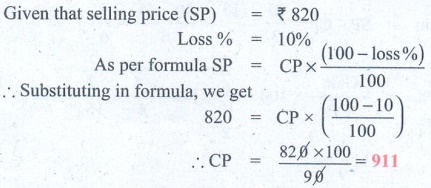
Solution 2:
Given that selling price (SP) = ₹ 820
Loss % = 10%
As per formula SP = CP × [ (100 – loss%) / 100 ]
∴ Substituting in formula, we get
820 = CP × [ (100 – 10) / 100]
∴ CP = [ 820 × 100 ] / 90 = 911
3. If the profit earned on selling an
article for ₹810 is the same as loss on selling it for ₹530, then find the cost
price of the article.
Solution:
Case 1: Profit = Selling price (SP) − Cost price (CP)
Case 2: Loss = Cost price (CP) − Selling price (SP)
Given that profit of case 1 = loss of case 2
∴ P = 810 − CP
L = CP − 530
Since profit (P) = loss (L)
810 − CP = CP − 530
∴ 2CP = 810 + 530 =
1340 ⇒ C.P = 1340/2
∴ CP = 670
4. If the selling price of 10 rulers
is the same as the cost price of 15 rulers, then find the profit percentage.
Solution:
Let cost price of one ruler be x
Given that selling price (SP) of 10 rulers,
i.e., same as cost price (CP) of 15 rulers
∴ SP of 10 rulers =
15 × x = 15x
∴ SP of 1 ruler = 15x / 10 = 1.5x
∴ Gain = SP of 1 ruler − CP of 1 ruler = 1.5x − x =
0.5x

Gain % = [ Gain / CP ] × 100 = [ 0.5x / x ] × 100
= 50%
5. Some articles are bought at 2 for
₹15 and sold at 3 for ₹25. Find the gain percentage.
Solution:
Let cost price of one article be C.P
Given that 2 are bought for
₹ 15
∴ 2 × CP = 15 ⇒ CP= 15/2
Let selling price of one article be SP
Given that 3 are sold for ₹ 25
∴ 3 × SP = 25 ⇒ SP = 25/3
∴ Gain = SP – CP = 25/3 – 15/2 = [50 – 45] / 6 = 5/6

Gain % = [Gain / CP] × 100 = [ (5/6) / (15/2) ] × 100 = [ 5/6 ×
2/15 ] × 100 = 100/9
= 11 1/9 %
6. By selling a speaker for ₹768, a man
loses 20%. In order to gain 20%, how much should he sell the speaker?

Solution 1:
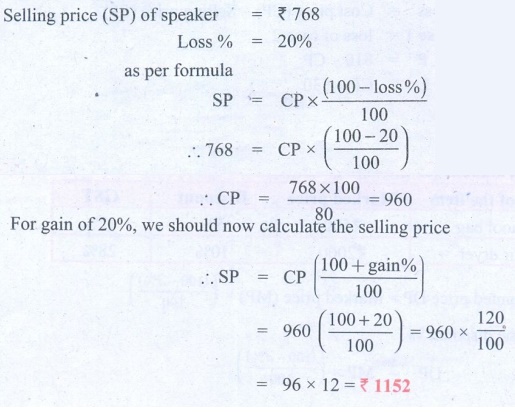
Solution 2:
Selling price (SP) of speaker = ₹ 768
Loss % = 20%
as per formula
SP = CP × [ (100 − loss %) / 100 ]
∴ 768 = CP × [ (100 – 20) /100 ]
∴ CP = [ 768 × 100 ] / 80 = 960
For gain of 20%, we should now calculate the selling price
∴ SP = CP [ (100 + gain%) / 100]
= 960 [ (100 + 20) /100 ] = 960 × (120 / 100)
= 96 × 12 = ₹ 1152
7. Find the unknowns x, y
and z.

Solution 1:
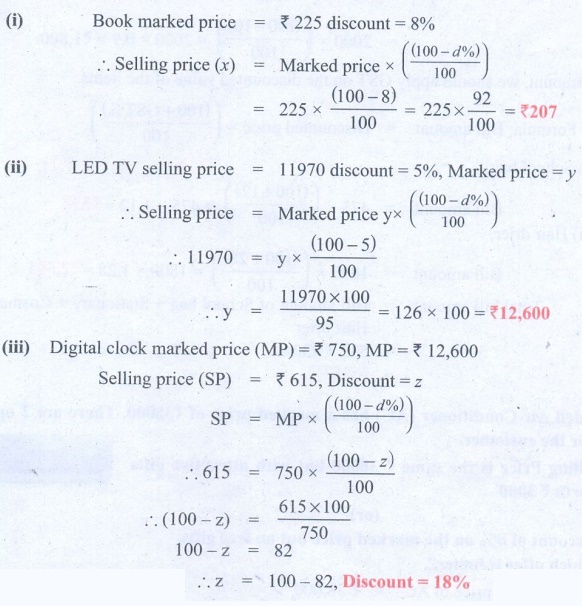
Solution 2:
(i) Book marked price = ₹225 discount =
8%
∴ Selling price (x)
= Marked price × [ (100 – d%) / 100 ]
= 225 × [ (100 – 8) / 100] = 225 × [92 / 100] = ₹ 207
(ii) LED TV selling price = 11970 discount
= 5%, Marked price = y
∴ Selling price = Marked price y × [(100 – d%) / 100]
∴ 11970 = y × [ (100 – 5) / 100 ]
∴ y = [11970 × 100] / 95 = 126 × 100 = ₹ 12,600
(iii) Digital clock marked price (MP) = ₹
750, MP = ₹ 12,600
Selling price (SP) = ₹ 615, Discount = z
SP = MP × [ (100 – d%) / 100 ]
∴ 615 = 750 × [ (100 – z) / 100 ]
∴ (100 − z) = [615
× 100] / 750
∴ 100 – z = 82
∴ z = 100 − 82, Discount
= 18%
8. Find the total bill amount for the
data given below:

Solution 1:
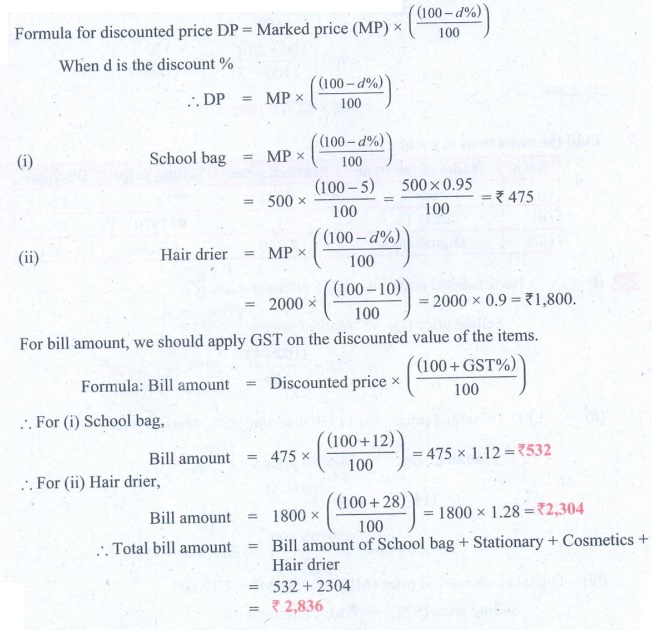
Solution 2:
Formula for discounted price DP = Marked price (MP) × [ (100 – d%) / 100 ]
When d is the discount %
∴ DP = MP × [(100 – d%) / 100]
(i) School bag = MP × [(100 – d%) / 100]
= 500 × [ (100 – 5) / 100 ] = [500 × 0.95] / 100 = ₹ 475
(ii) Hair drier = MP × [ (100 – d%) / 100 ]
= 2000 × [(100 – 10) / 100] = 2000 × 0.9 = ₹ 1,800
For bill amount, we should apply GST on the discounted value of
the items.
Formula: Bill amount = Discounted price × [ (l00 + GST%) / 100 ]
∴ For (i) School bag,
Bill amount = 475 × [ (100
+ 12) / 100 ] = 475 × 1.12 = ₹ 532
∴ For (ii) Hair
drier,
Bill amount = 1800 × [ (100 + 28) / 100 ] = 1800 × 1.28 = ₹
2,304
∴ Total bill amount =
Bill amount of School bag + Stationary + Cosmetics + Hair drier
= 532 + 2304
= ₹ 2,836
9. A branded Air-Conditioner (AC) has
a marked price of ₹38000. There are 2 options given for the customer.
(i) Selling Price is the same ₹38000
but with attractive gifts worth ₹3000
(or)
(ii) Discount of 8% on the marked price
but no free gifts. Which offer is better?

Solution:
Marked price of AC = ₹ 38,000
Option 1:
Selling price = ₹ 38000 & gifts worth ₹ 3000
Net gain for customer = ₹ 3000 as there is no discount on AC
Option 2:
Discount of 8%, but no gift
∴ Discounted value = MP × [ (l00 − d%) / 100 ]

= 38000 × [ (100 – 8) / 100 ] = 38000 × 0.92 = 34960
Savings for customer = 38000 – 34960 = ₹ 3040
Therefore, the customer gets 3000 gift in option 1 where as he
is able to save only ₹ 3040 in option 2. Therefore, option 2 is better.
10. If a mattress is marked for ₹7500
and is available at two successive discounts of 10% and 20%, find the amount to
be paid by the customer.
Solution:
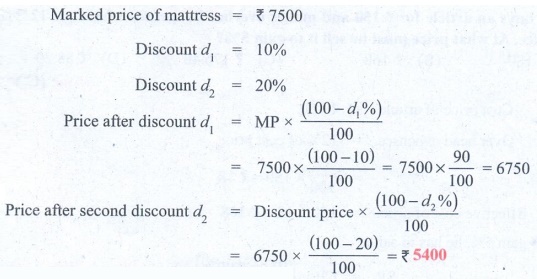
Solution 2:
Marked price of mattress = ₹
7500
Discount d1
= 10%
Discount d2
= 20%
Price after discount d1
= MP × [ (100 − d1%)
/ 100 ]
= 7500 × [ (100 − 10) / 100 ] =
7500 × 90/100 = 6750
Price after second discount d2 = Discount price × [ (100 − d2
%) / 100 ]
= 6750 × [ (100 − 20) / 100 ]
= ₹ 5400
Objective
Type Questions
11. A fruit vendor sells fruits for ₹200
gaining ₹40. His gain percentage is
(A)20%
(B) 22%
(C) 25%
(D) 16 2/3
%
[Answer: (C) 25%]
Solution:
Selling price = ₹ 200
Gain = 40
∴ CP = Selling price − gain = 200 – 40 = 160

Gain % = [Gain / CP] × 100 = [40 / 160] × 100 = 25%
12. By selling a flower pot for ₹528,
a woman gains 20%. At what price should she sell it to gain 25%?
(A) ₹500
(B) ₹550
(C) ₹553
(D) ₹573
[Answer: (B) ₹ 550]
Solution:
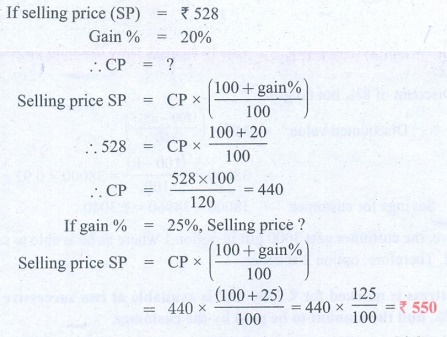
Solution 2:
If selling price (SP) = ₹
528
Gain % = 20%
∴ CP = ?
Selling price SP = CP × [ (100
+ gain %) / 100 ]
∴ 528 = CP × [ (100 + 20) / 100 ]
∴ CP = [528 × 100] / 120 = 440
If gain % = 25%, Selling
price?
Selling price SP = CP × [ (100
+ gain%) / 100 ]
= 440 × [ (100 + 25) / 100 ] =
440 × [125 / 100] = ₹ 550
13. A man buys an article for ₹150 and
makes overhead expenses which are 12% of the cost price. At what price must he sell
it to gain 5%?
(A) ₹180
(B) ₹168
(C) ₹176.40
(D) ₹88.20
[Answer: (C) 176.40]
Solution:
Cost price of article = ₹ 150
Over head expenses = 12% of cost price
= (12 / 100) × 150 = ₹ 18
∴ Effective cost of article = 150 + 18 = ₹ 168
Now, to gain 5%, he has to sell at

SP = CP × [ (100 + gain%) / 100]
= 168 × [ (100 + 5) / 100] = 168 × 1.05 = 176.40
14. What is the marked price of a hat
which is bought for ₹210 at 16% discount?
(A) ₹243
(B) ₹176
(C) ₹230
(D) ₹250
[Answer: (D) ₹ 250]
Solution:
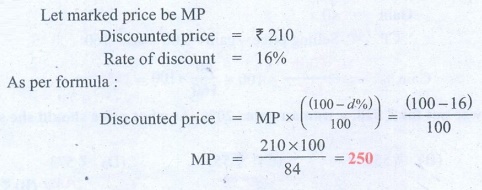
Solution 2:
Let marked price be MP
Discounted price = ₹ 210
Rate of discount = 16%
As per formula :
Discounted price = MP × [ (100 – d%) / 100 ] = (100 – 16) / 100
MP = [210 × 100] / 84 = 250
15. The single discount in % which is
equivalent to two successive discounts of 20% and 25% is
(A) 40%
(B) 45%
(C) 5%
(D) 22.5%
[Answer: (A) 40%]
Solution:
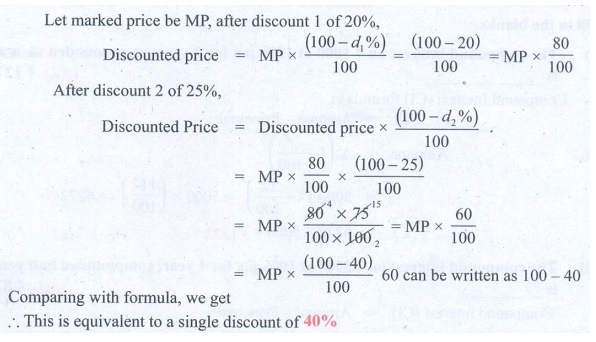
Solution 2:
Let marked price be MP, after discount 1 of 20%,
Discounted price = MP × [ (100 – d1%) / 100 ]
= [100 – 20] / 100 = MP × [80/100]
After discount 2 of 25%,
Discounted price = Discounted price × [ (100 – d2%)
/ 100 ]
= MP × 80/100 × [ (100 – 25) / 100 ]
= MP × [ (80 × 75) / (100
× 100) ] = MP × (60 / 100)
= MP × [ (100 – 40) / 100 ] 60 can be written
as 100 − 40
Comparing with formula, we get
∴ This is equivalent to a
single discount of 40%
Answer:
Exercise 4.2
1. (i) Cost price (ii)
₹7000 (iii) ₹600 (iv) 8% (v) ₹945
2. ₹902
3. ₹670
4. 50%
5. 11 (1/9) %
6. ₹1152
7. (i) x = ₹207 (ii) y = ₹12600 (iii) z = 18%
8. ₹2836
9. Discount of 8% is
better
10. ₹5400
11. (C) 25%
12. (B) 550
13. (B) 168
14. (D) ₹250
15. (A) 40%
Related Topics